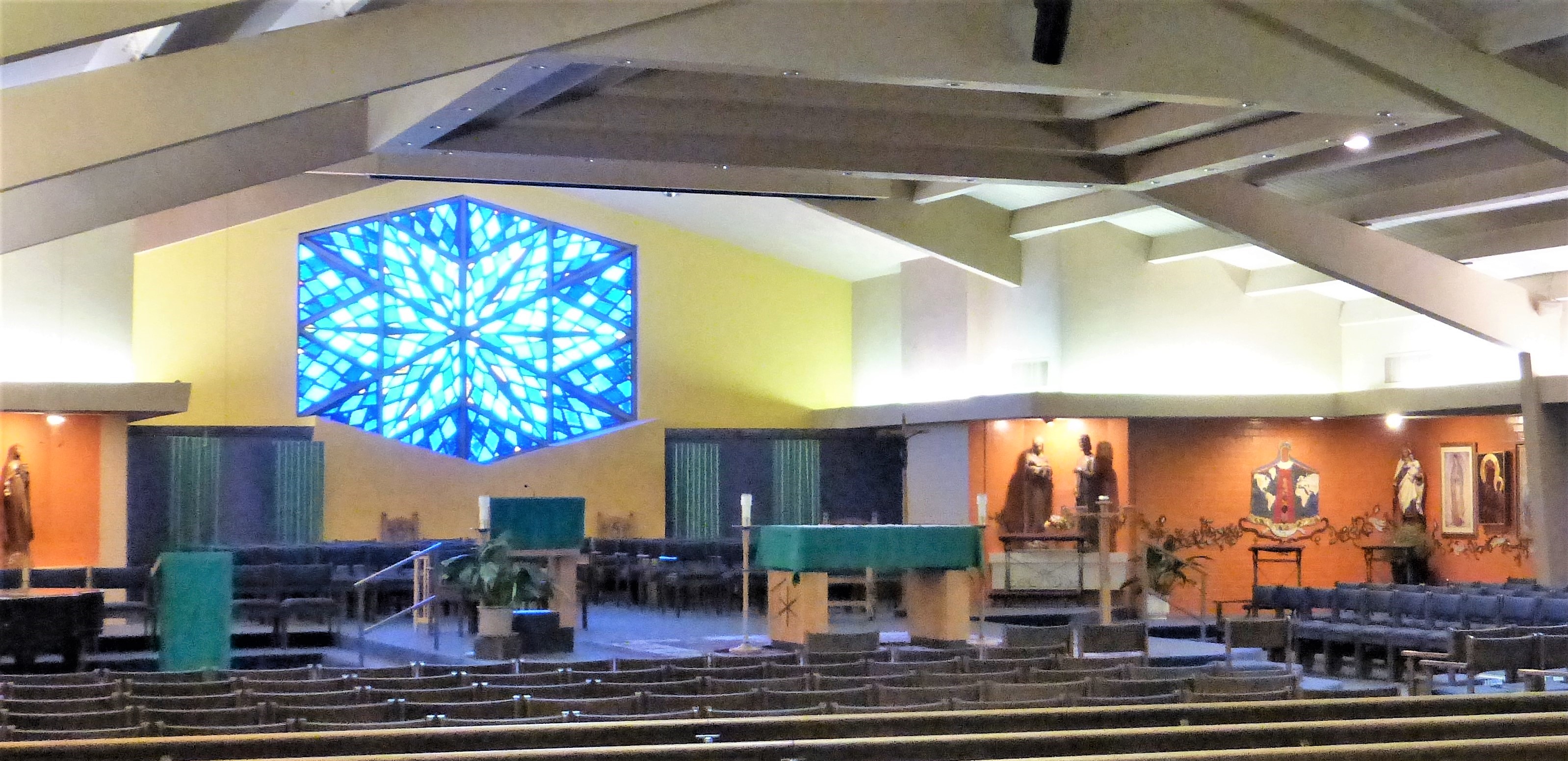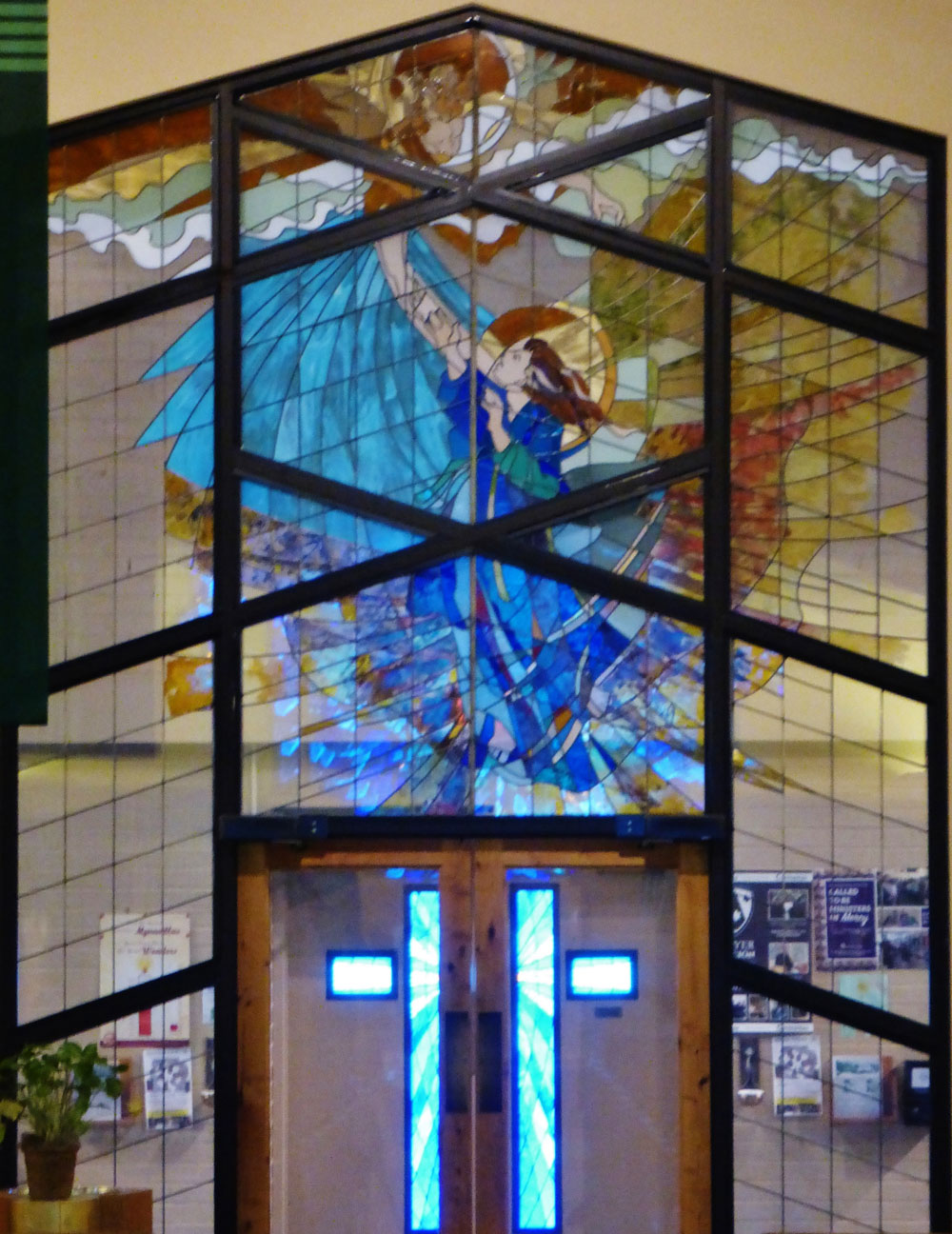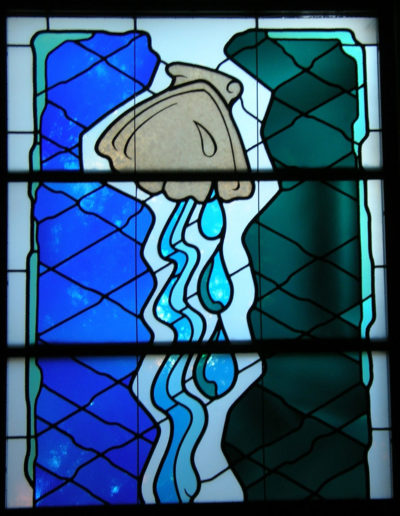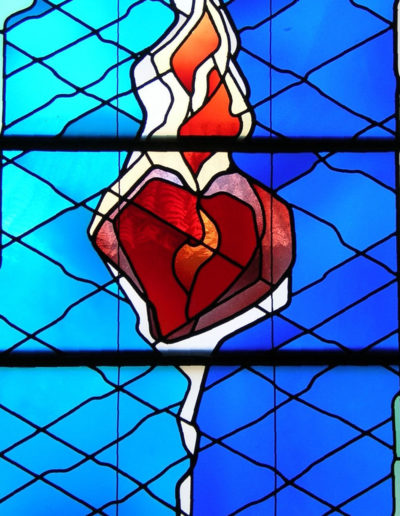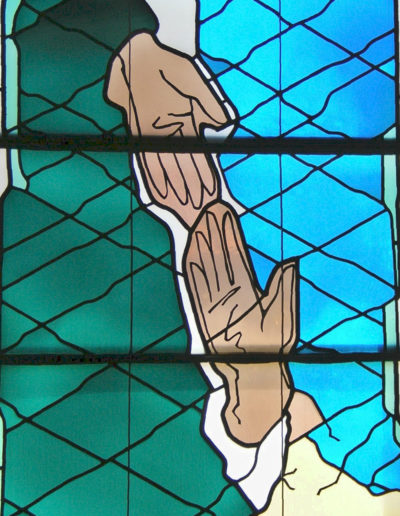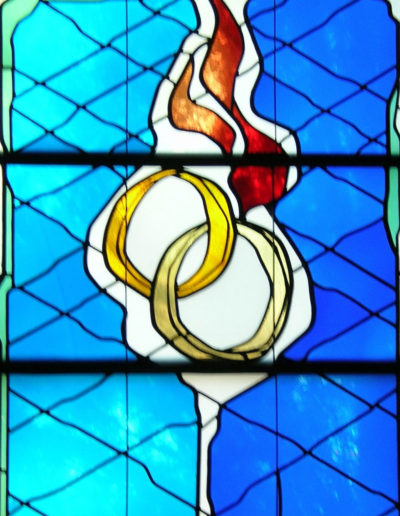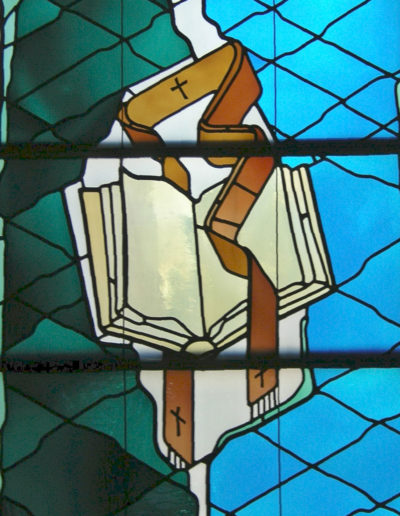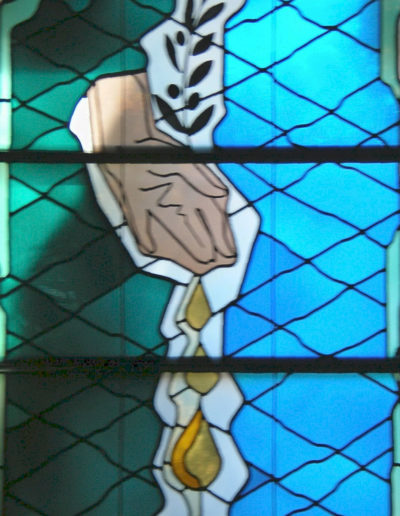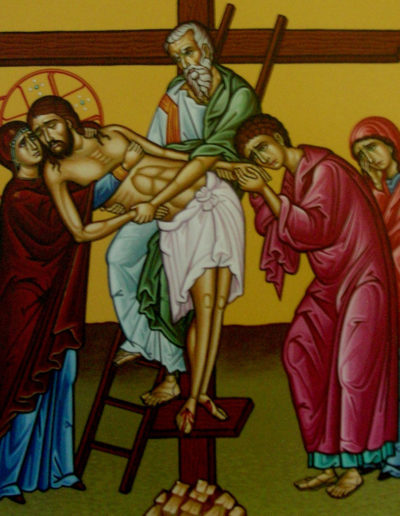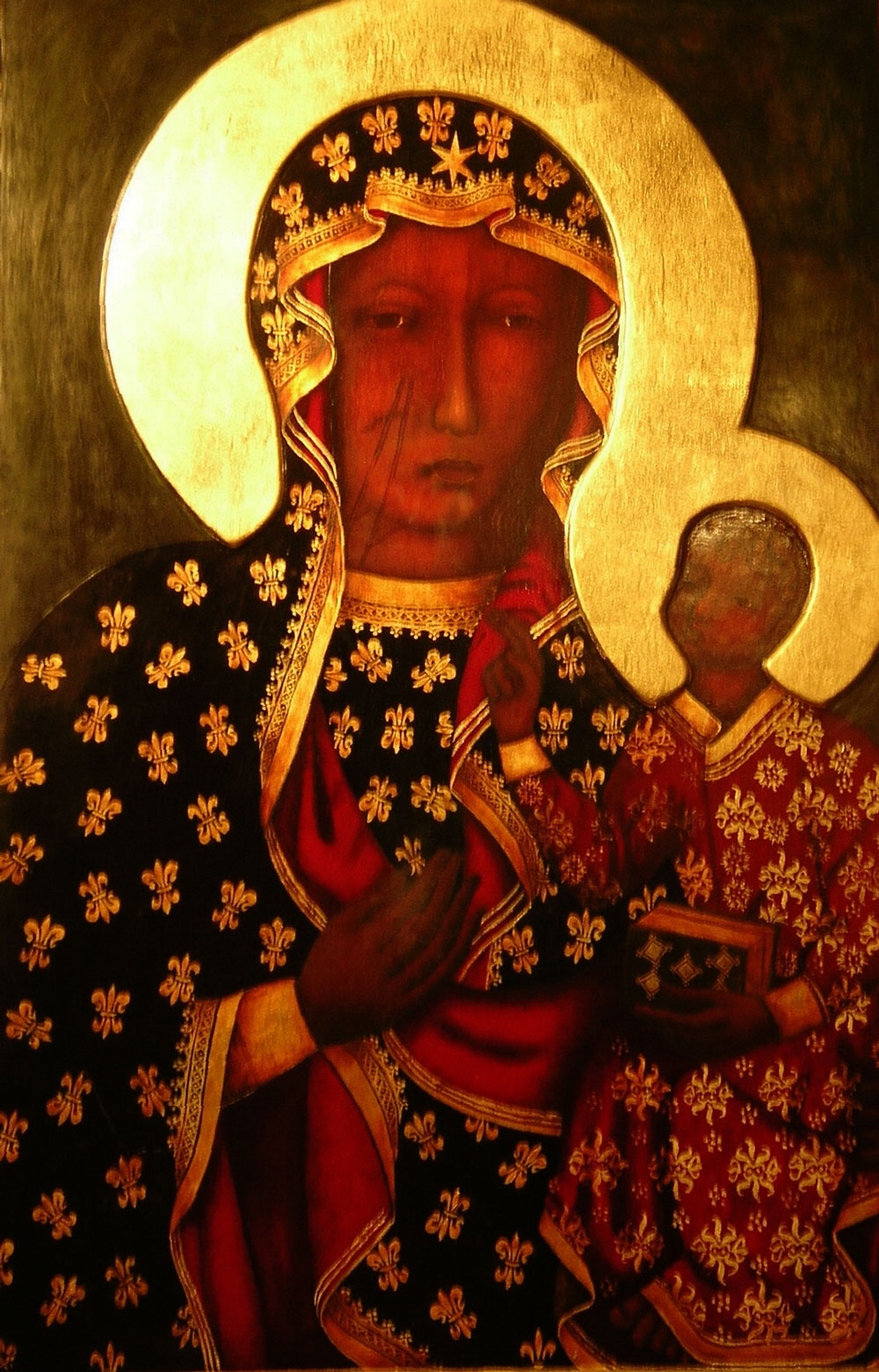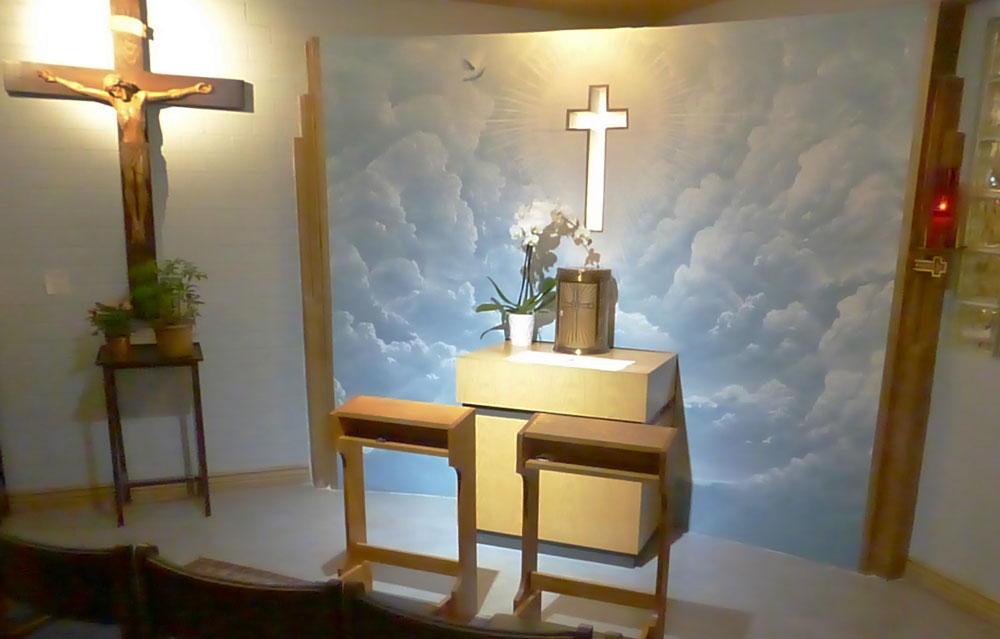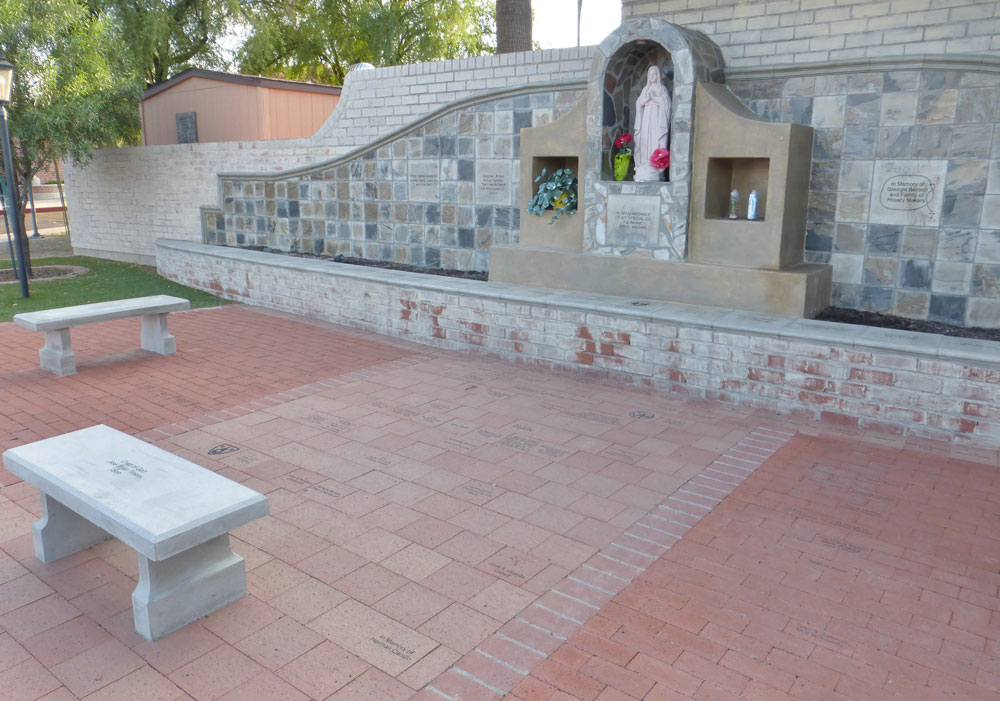The Church…
The parish’s first permanent church building was constructed in 1951. It now serves as one of two parish halls (Nicholson Hall – so named in honor of Marie Nicholson, former Principal of the parish’s school and later parish staff member).
In 1970, the current building became the parish’s church. Since that time, the worship space has undergone several renovations.
At the Entrance in the Vestibule…
At the Entrance in the vestibule…
The church underwent its first major renovation under the guidance of Fr. Bill Dougherty, C.S.P. (the Paulist Father serving as pastor during that time). This renovation moved the main altar from a recessed “sanctuary area” forward into the midst of the assembly in keeping with the renewed vision of the Church’s liturgy promoted by Vatican II.
The second major renovation occurred in the summer and fall of 2005 under the guidance of Fr. Gil Martinez, C.S.P. (the last Paulist Father to serve as pastor of the parish). One experiences the fruits of this labor upon entering the vestibule. A low ceiling was removed exposing the original, high wood beams. A wall with windows separating the vestibule from the nave was also constructed allowing the vestibule to have a dual function – entryway and area for parents to take infants and young children when they get noisy and/or restless during liturgical celebrations.
At that time, the stained-glass depiction of the Annunciation (by Maureen McGuire) above the inner set of main doors was commissioned and installed. It images the greeting of Mary by the Archangel Gabriel described by St. Luke in his Gospel (1:30):
“The angel said, ‘Do not be afraid, Mary, for you have found favor with God.’”
Our patron, Saint Cyril of Alexandria held Mary in great devotion. He was instrumental in the Church’s development of the theology of Mary as Theotokos. This is the doctrine which declares that Mary is the Mother of God. It is actually more a statement about Jesus than Mary. With this doctrine, the Church declared that Jesus is fully human and fully divine. The foundation for Cyril’s understanding of this dual nature of Jesus came from his reflection on the Annunciation in which the angel went on to say, “the child to be born will be called holy, the Son of God.” (Luke 1:35)
Reminiscent of the nearly touching outstretched fingers of God and Adam in Michelangelo’s fresco of the creation of humanity in the Sistine Chapel, you see Mary’s open hand just beneath the outstretched finger of the angel Gabriel reminding us that Mary’s “let it be according to your word” has created us anew by welcoming Jesus into the world. With this same openness, we welcome all who enter the church. People of every faith, language, race, and way of life are welcome!
On the west wall of the vestibule is a depiction of our patron, St. Cyril of Alexandria. Created by Fr. Frank Sabatte, C.S.P. (a member of the Paulist Fathers and former Parochial Vicar at the parish), it is a random-stitch free-motion machine embroidery and applique. St. Cyril is wearing the traditional garb of a bishop of his time (early 4th century). The fingers on his right hand are in the traditional position representing the Trinity and he is holding the Sacred Scriptures. (For more information about Fr. Frank Sabatte’s art, visit his website: www.sabatte-arts.com.)
In the nave of the church…
The most eye-catching item in the nave is the blue & gold hexagonal faceted-glass window on the south wall behind the main altar. Included in the original construction of the church, it has become the parish’s “signature.” When speaking about the parish with Tucsonans, they often remark “Oh, is that the church with the big blue window?”
This window was used as the inspiration for the cast iron sculpture above the main doorway and the stained-glass inserts in the main doors for a 2012 renovation. This renovation included new bathrooms in the vestibule, a Reconciliation Chapel / Lactation Station room and a statute of St. Cyril of Alexandria on the north-east corner of the church near the main entry on the east side of the building.
The Blessed Sacrament Chapel…
On the west side of the nave (to the left of the main altar) is the Blessed Sacrament Chapel. One can access the chapel from the nave when the church is open or from an exterior door when the church is closed. It is usually opened from 7:30 AM until 7:00 PM daily (except on national holidays).
As its own chapel, parishioners have an area for quiet personal prayer not only during the day but before and after Mass and/or other celebrations in the church.
Development of the chapel as a separate space was a gift of Hilda Rodriguez and her son Rogelio (Rogo) Rodriguez. Along the entry wall of the chapel is a painting of The Last Supper by Fr. Frank Sabatte, C.S.P. The mural behind the tabernacle, entitled The Heavens, was painted by Ignacio Garcia. The large crucifix originally hung over the main altar prior to the renovation of the altar space. Along with the stained glass window imaging the Anointing of the Sick is one with the Alpha and Omega (the first and last letters of the Greek Alphabet) used to describe the Lord Jesus as “the beginning and the end.”
There is a large stainless-steel vessel in the chapel from which persons may obtain Holy Water for their personal use.
The Bells of St. Cyril…
Hanging from the bell tower of the original church building (now Nicholson Hall) was an 800-pound bell. Unique in its design, the bell never swung to ring. Rather it had 3 electrically controlled hammers on its exterior which would ring the bell.
During its time in the bell tower of the first church, it was stolen. Cut down from its lofty perch, leaving quite a hole in the ground upon which it fell, the bell went missing for some time. It was found and returned to the parish and, later, hung in the bell tower of the new church building.
In time, the mechanism for ringing the bell deteriorated and it no longer rang out. Replacing it was an electronic system – a gift to the parish by Martha and Dionicio Naranjo in memory of their daughter Chely. It too has run its course and no longer is able to ring out.
In 2017, Chris Christopher (a retired electrical engineer) and members of our parish’s Knights of Columbus Council, stepped forward and offered to reactivate the original bell ringing system. While quite a challenge to procure needed parts for an old and unique system, he was able to restore the mechanism and now the bell rings once again – the Angelus three times a day (8:00 AM; 12:00 & 6:00 PM) as a Call to Worship before Masses and other liturgical celebrations and as a Funeral Toll at the end of funerals.
The Marian Plaza…
On the grounds of the parish, on the west side of the Parish Office building, there was a Marian grotto made of stone and cement. It had been donated by a couple who moved from the area many years ago. It had been in their backyard. Not sure who would be buying their home, they donated the grotto to the parish. Over time, a line of Italian Cypress trees were planted and grew in this area resulting in overshadowing the grotto. When the trees became infected with an airborne disease, they were cut down and the grotto was exposed once again, but without any image of Mary in it. In addition, the removal of the trees exposed a nice size parcel of land but with nothing more on it than the empty grotto. To beautify this area and to honor the donation, it was decided to construct a Marian Plaza in this space. The original grotto needed work to make it more aesthetically pleasing. However, when planning out the plaza’s surface, it was noticed that the grotto lay crooked to the lines of the intended plaza. The result was the decision to remove the original grotto and to construct a new grotto for what would be The Marian Plaza.
The shrine has an image of Mary as the Immaculate Conception (Patroness of the US). Two open niches are on either side of the statue to allow for vigil candles to be placed by the image of Mary. The plaza is a memorial plaza honoring individuals and families, both living and deceased. Benches on the plaza allow for parishioners and visitors to linger and pray or just rest by themselves or in the company of friends.
Views: 2147

